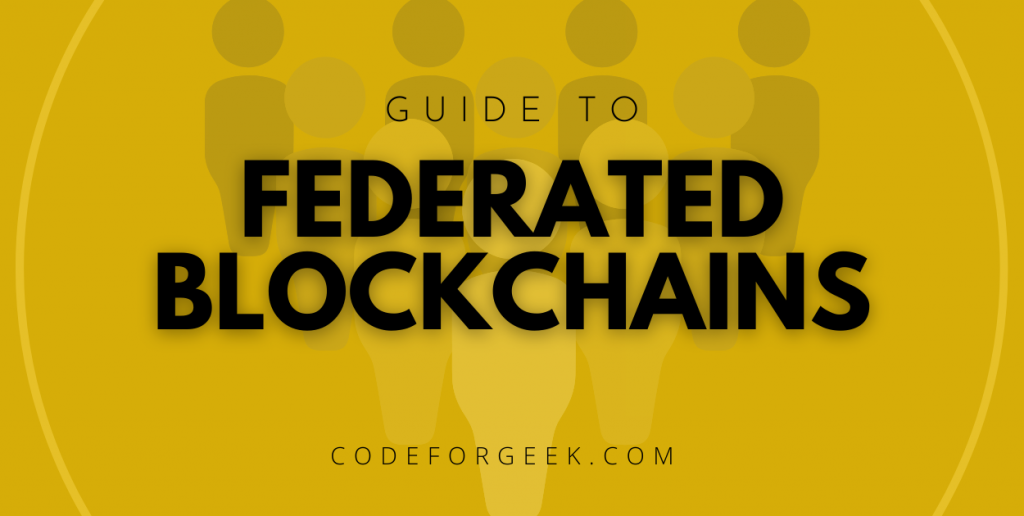Most of you who read about blockchains might know they are different types of blockchains. Federated Blockchains are what we are discussing today.
So, basically, there are 4 types of blockchains: private, public, hybrid, and federated blockchains.
Blockchain technology has been since 2009 now which is obviously more than a decade. The technology has seen various modifications and advancements in its growing stages.
The main agenda of this technology was to initialize a digital currency or cryptocurrency ecosystem that runs in a trustless system, meaning users do not have to trust or know each other or a third party, for the ecosystem to work.
This is a great solution to tackle the defective and conventional centralized systems. Still, the publicly distributed ledger system can prove to be both a blessing and a curse especially for companies that handle sensitive data. So, is there a way these organizations can control a notable technology like this one?
With the innovation of federated blockchains, it is now possible. Federated blockchains are a relatively new and interesting concept in the world of blockchain. Most people haven’t yet realized its potential and benefits.
Let us learn about what federated blockchains are, how are they different from private blockchains and how do they work. So, let’s get started!
What are Federated Blockchains or Blockchain Consortia?
Before I dive deep into federated blockchains or blockchain consortia, let me first explain to you what private blockchains are because they are quite similar.
What are Private Blockchains?
Private blockchains are developed and maintained by a private organization/firm/enterprise. This organization solely exercises control over the mining process and consensus algorithm.
In this type of network, users or participants who join and use the blockchain network and/or download nodes, are decided by the owning organization.
Well, you’re not wrong if you think it isn’t so decentralized for a blockchain. In a private blockchain, no one is given the authority to read, write or audit the system anytime. Besides, the enterprise/organization may even override the blockchain command or delete it, if it desires!
Private blockchains are based on a shared or decentralized ledger, access to these ledgers is given only to the firm’s chosen users. However, if the firm wills, it may also give read, write or audit permissions to the public.
Read about private blockchains in detail here.
Federated Blockchain: The Missing Piece
The first question on your mind must be where do federated blockchains fall in this situation. Well, federated networks or blockchain consortia have many similarities to private networks, however, there are noteworthy differences.
To begin with, a federated blockchain removes the influence of a single authority that is the organization. Meaning, the network is used by several other entities and brings back the decentralized model.
Hence, rather than just one organization controlling or in charge, you will find multiple other organizations using the blockchain for their purposes and benefit.
You may formulate an idea of it as a hub where multiple enterprises are exchanging information or data and working at the same time. It can also be thought of as a clustered database.
in such settings, it becomes feasible for consumers to get work done faster that requires the involvement of multiple companies. These clusters/groups may come together in a federated blockchain network and modify it to be able to use it smoothly and efficiently.
This is the reason why this type of blockchain technology is popularly known as federated networks or blockchain consortia.
How do Federated Blockchains Work?
Now that we understood what a federated blockchain is and how it is different from private blockchains, let us now move on to understanding how the technology works.
Let us start with an example. Suppose, a blockchain network has 15 companies working together on it. From these 15 firms, a node will be selected by default that makes changes on the network.
These nodes are allowed to read or write transactions and may even allow or restrict users on the network. Now here’s a question. Will, any of these nodes be authorized to add a block in the database?
The answer is no. for any node to be able to or be authorized to so to say, add a block in the blockchain, every single node network must first verify the block. If in case even one of them disapproves or rejects the addition of block, then it would not be added to the ledger or blockchain.
This ensures that no one can encroach on their superior access and is something that doesn’t exist in private blockchains.
So, how are new blocks added to the network?
Proof-of-Vote
Decisions are reached based on a voting system. Hence, the consensus algorithm used by federated blockchains is the Proof-of-Vote mechanism, which is quite new.
The popular algorithms are Proof-of-Work (PoW) and Proof-of-Stake (PoS). However, mechanisms can’t cope with the needs of a federated network.
This resulted in the invention of the new voting consensus mechanism called the Proof-of-Vote (PoV). In this mechanism, the selected nodes are followed up and these nodes will vote for a block to be validated or not.
The number of votes required to validate that block is pre-determined. Coming back to our example, we conclude that for 15 selected nodes, it might take votes from 12 nodes or even 15 nodes to sign off a block.
Conclusion
Most of you who read about blockchains might know they are different types of blockchains. Federated Blockchains are what we are discussing today. Read about what federated blockchains are, how are they different from private blockchains and how do they work.

